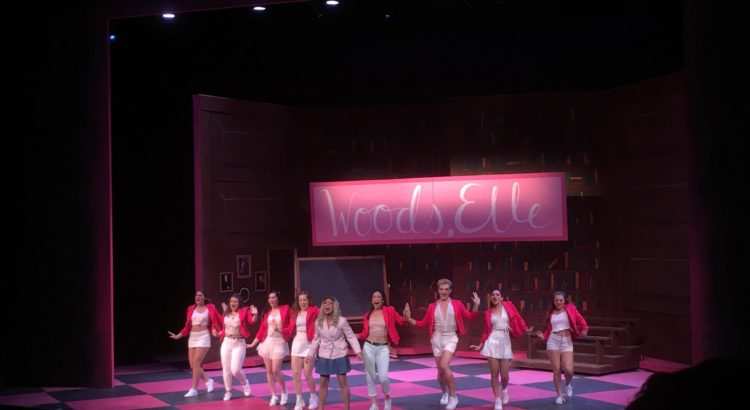Legally Blonde is the story of positivity, hard work, and feminism, embodied by the great and legendary Elle Woods. MUSKET’s performance elevated this musical to stunning heights, full of laughter and empowerment and the best talent on campus.
The musical started out with squealing sorority girls excited about Elle and Warner’s potential engagement. When the fabulous Mika Secada emerged as Elle Woods, she instantly dominated the stage with her pink attire and commanding presence, even after Warner breaks Elle’s heart with his egoistic dreams. Dominic Dorset portrays him as a suave man fit right into Harvard, and Elle studies hard to get in to chase after him, even performing a lovely cheerleading routine sprinkled with law jargon to convince the Harvard men of her capabilities.
Once in Harvard, preppy girl Vivienne Kensington (Mackenzie Mollison) is out for Elle’s blood, but soft and geeky Emmett (Michael Dietz) is there to show her she belongs. Nevada Riley, Kaitlyn Tom, and Ryan Moore made the perfect Greek Chorus, giving Elle the strength and encouragement to be the Elle Woods we all admire.
In the hair salon, we meet Paulette, and Emma Cook’s dialect and hairstyle and outfit rivaled the Paulette in the original movie. Her positivity and energy was contagious, and she dominated the stage as well. One of the biggest stars of the show was Reggie the Campus Corgi, the crowd erupting into applause and cheers as he waddled his way across the stage after Elle helped Paulette win her dog back.
Sydney C. Shepherd played Brooke Wyndham, the accused fitness guru with style and moves. The extraordinary choreography of “Whipped Into Shape” involving synchronized jump roping was really impressive as the cast did a thorough workout to this extremely catchy song. Probably the best part of this number was when Ryan Moore’s jump rope flew out of his hands, and he started jumping up and down with his own unique flair that made it super entertaining to watch.
The vocal power of this cast was extraordinary, especially Secada’s performances. As she danced and marched around in stilettos, she proved how powerful and confident women could be. From fashion icon to winning lawyer, her positive and outgoing mindset helped her succeed, and Secada grabbed this narrative we’re all familiar with and turned it into her own. Vivienne’s unwavering support for Elle after Callahan assaulted her was even more poignant as Mollison sang “legally blonde”, nailing that run over and over again.
The set was simple and beautiful, yet it screamed Elle Woods. The revolving walls brought us between the bright pink walls, the blue salon, and Harvard with effective ease. Once again, the pit’s brilliantly-played music matched Elle Wood’s spirit and gave her an upbeat soundtrack to her life. This all-star cast, from Cook to Mollison to Reggie to Secada, turned this story about a sorority girl turned lawyer into a moving tale about self-empowerment and the importance of believing women. Bruna D’Avila and MUSKET exceeded expectations again with this very pink, very enjoyable, and very powerful musical.










